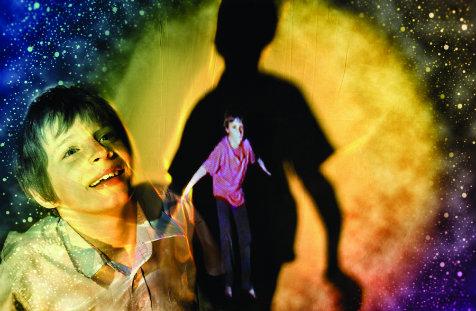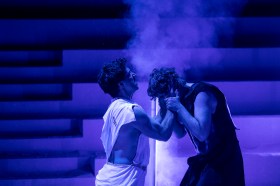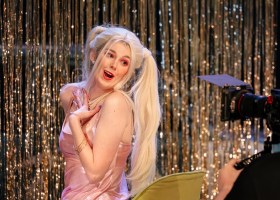Shadow Dreams, a play for children about children and the dreams they share, is an audacious adventure in digital puppetry and a moving story of cross-cultural learning.
The production takes a further step in what has been an ongoing exploration of digital technologies in the work of Terrapin Puppet Theatre, winners of a 2012 Helpmann Award for Boats.
Long-time collaborators Frank Newman (director) and Finegan Kruckemeyer (writer) again join forces, this time meeting the challenge of how to realise a central but abstract conceit in an otherwise simple script.
Two boys, one from the city, one from the land; one white, the other Aboriginal, start having each other’s dreams. Their respective elders (Nan, Uncle George) explain to the boys that what they are having are shadow dreams.
Shadow Dreams is one play, performed in real time, in two locations, hundreds of kilometres apart. That’s a tall order, a ‘world first’ made possible by broadband connections, 12 laptops, and assorted microphones and video cameras on both stages.
At Hobart’s Conservatorium Recital Hall we saw live action on our stage, which was divided in two, with painted backdrops behind one half and a big video screen behind the other. The reverse was set up at Launceston’s Annexe Theatre and the interaction between players occurred live and with almost imperceptible delay. Puppet artists had their own performance area and they performed both to us and to a camera for the benefit of the other audience.
Into this mix add an ensemble of musicians from the Tasmanian Symphony Orchestra, also performing live, and you begin to wonder at the audacity of such a project. The technical cue sheet would have stretched to many pages.
So why set up such hurdles in the first place? In part because of the insubstantial nature of dreams themselves, but also because the underlying message of Shadow Dreams speaks of respect for each other’s stories and cultural rapprochement. And this process of coming together is shown to us, simply and movingly, with the mediation of technology.
If I had any reservations about this production, it would be that actual puppets, though they are used to explain Aboriginal and western stories alike, seem somewhat subordinated to the technical bravura of the piece.
I also felt the action on stage looked a little unadorned, a little small in the space. This show has few of the bright lights and big colourful effects of earlier Terrapin shows like The Falling Room and the Flying Room, which young children find so appealing. I would say Shadow Dreams best suits kids over the ages of 6 or 7.
Performances were a little under the usual very high Terrapin standard, though I loved Mel King as the daggy best friend, Gilbert. Terrapin must be given its due for its partnership with the Tasmanian Aboriginal community, not only in careful research, but also in its development of debut Indigenous performers, and puppet makers.
My final thoughts go to the contribution of Graeme Koene’s specially commissioned score. By turns lyrically sweet then emotionally soaring, it added enormous pleasure and an extra dimension to this complex and satisfying production.
Rating: 3 ½ stars out of 5
Terrapin Puppet Theatre presents
Shadow Dreams
Director: Frank Newman
Writer: Finegan Kruckemeyer
Composer: Graeme Koehne
Aboriginal Story Consultant: Fiona Hamilton
Designer: Selena de Carvalho
Assistant Director: Sam Routledge
Lighting Designer/Operator: Jason James
Conductor: Brett Kelly
Performed by: Kirsty Grierson, Mel King, Elliott Maynard,
Nathan Maynard, Kai Raisbeck and Merinda Sainty
Featuring members of the Tasmanian Symphony Orchestra in Hobart, Launceston and Burnie
Conservatorium of Music, Hobart
15 – 17 March
Annexe Theatre, Inveresk
15 – 16 March
Burnie Arts & Function Centre
17 March
Ten Days on the Island 2013
www.tendaysontheisland.com
15 – 24 March






